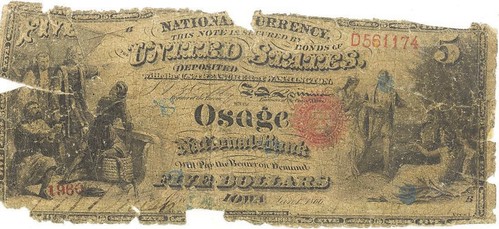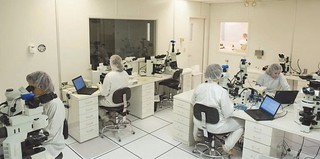
PREV ARTICLE
NEXT ARTICLE
FULL ISSUE
PREV FULL ISSUE
LABORATORY ANALYSIS OF STOLEN CURRENCY
Paper Money is the official publication of the Society of Paper Money Collectors (SPMC). Editor Benny Bolin kindly responded to my
request to publish this excerpt of an interesting article in the Mar/Apr 2016 issue by James C. Ehrhardt, PhD and Craig S. Schwandt, PhD
about the laboratory analysis of stolen currency. Thanks! -Editor
An accompanying article in this issue details the 1866 robbery of the Osage National Bank of Osage, IA, charter #1618. In brief, the door of the bank safe was blown off with gunpowder and among the stolen currency were crisp, unsigned, unissued $5 Original Series notes from the bank with serial numbers 1751 through 2200. The thieves forged the bank officers' signatures and distressed the notes before starting to pass them. Sixteen of the stolen notes have survived, mostly in tattered and torn condition. On the note pictured here, the stamped letter “S” is faintly visible in blue ink in several places to indicate its having been stolen. Laboratory Procedure

Both notes had been purchased from prominent numismatic sources. Our goal was to determine whether we could obtain evidence confirming their presence in the explosion of the bank safe. We looked for three different microscopic materials embedded on the surface of the notes. First, gunpowder residue may have survived the explosion. Next, a local newspaper reported that a roll of stolen currency recovered from the thieves was covered with “Plaster Paris.” This white powder was undoubtedly a proprietary fire-proofing material with which manufacturers of bank safes typically lined the safe walls, such as talc, asbestos, or gypsum. Finally, iron fragments would be strong evidence of an explosion.
Consult the article for details on the analytical process; I'll cut to the chase and excerpt the results next. -Editor
In summary, we have found three separate lines of evidence compatible with an origin in an explosion in a bank safe (iron oxide particles formed in a high temperature event, talc as a fire-proofing agent, and trace elements from gunpowder residue). These findings are somewhat speculative, and none are definitive. And of course we can not know how the notes may have become soiled or contaminated during the last 150 years. But we can say that our results are consistent with the robbery that was so well documented in 1866. We have demonstrated that modern, non-destructive laboratory analysis can provide information about currency not available in any other way. A wide variety of other technological methods are available in addition to those we have used. Perhaps special applications may be found for the study of certain paper, ink, counterfeits, DNA, etc. Researchers need to include these possibilities in their thinking.
How interesting to think a note in one's collection could be traced to an old-fashioned bank job. Nice work. To read more about the
analysis or the bank and its robbery, see the complete Paper Money issue. -Editor
For more information about the Society of Paper Money Collectors, see:
THE BOOK BAZARREWayne Homren, Editor The Numismatic Bibliomania Society is a non-profit organization promoting numismatic literature. See our web site at coinbooks.org. To submit items for publication in The E-Sylum, write to the Editor at this address: whomren@gmail.com To subscribe go to: https://my.binhost.com/lists/listinfo/esylum All Rights Reserved. NBS Home Page Contact the NBS webmaster 
|
